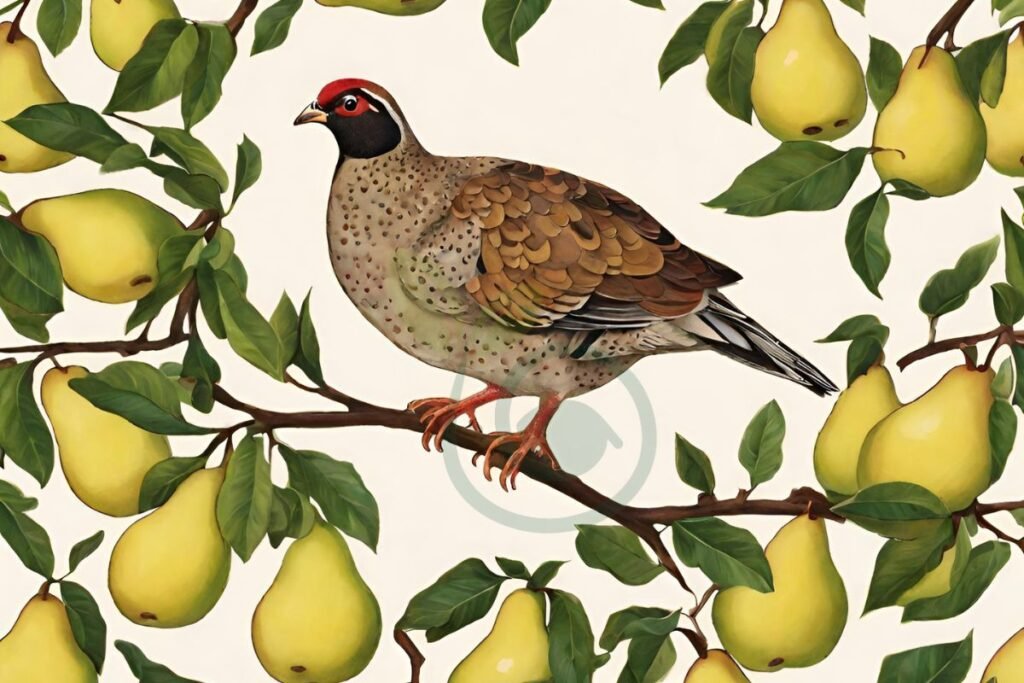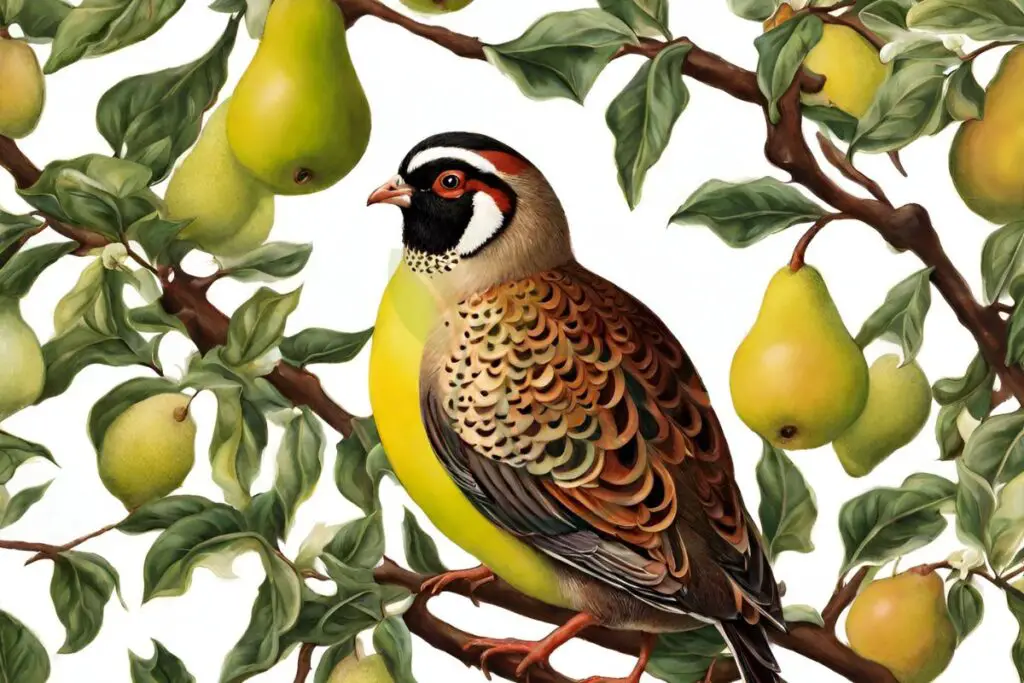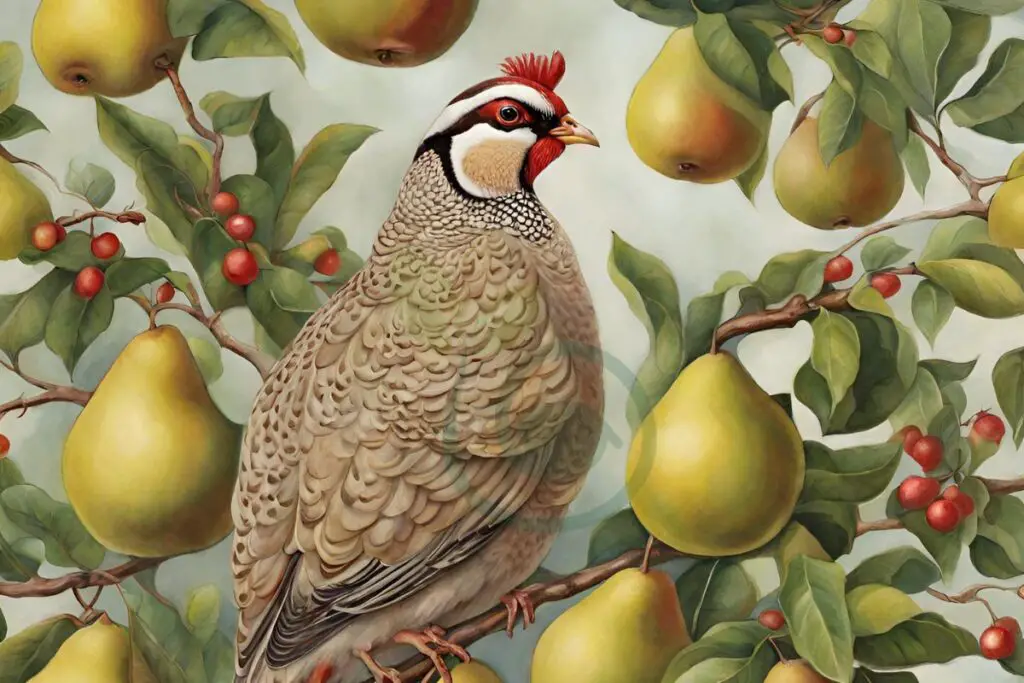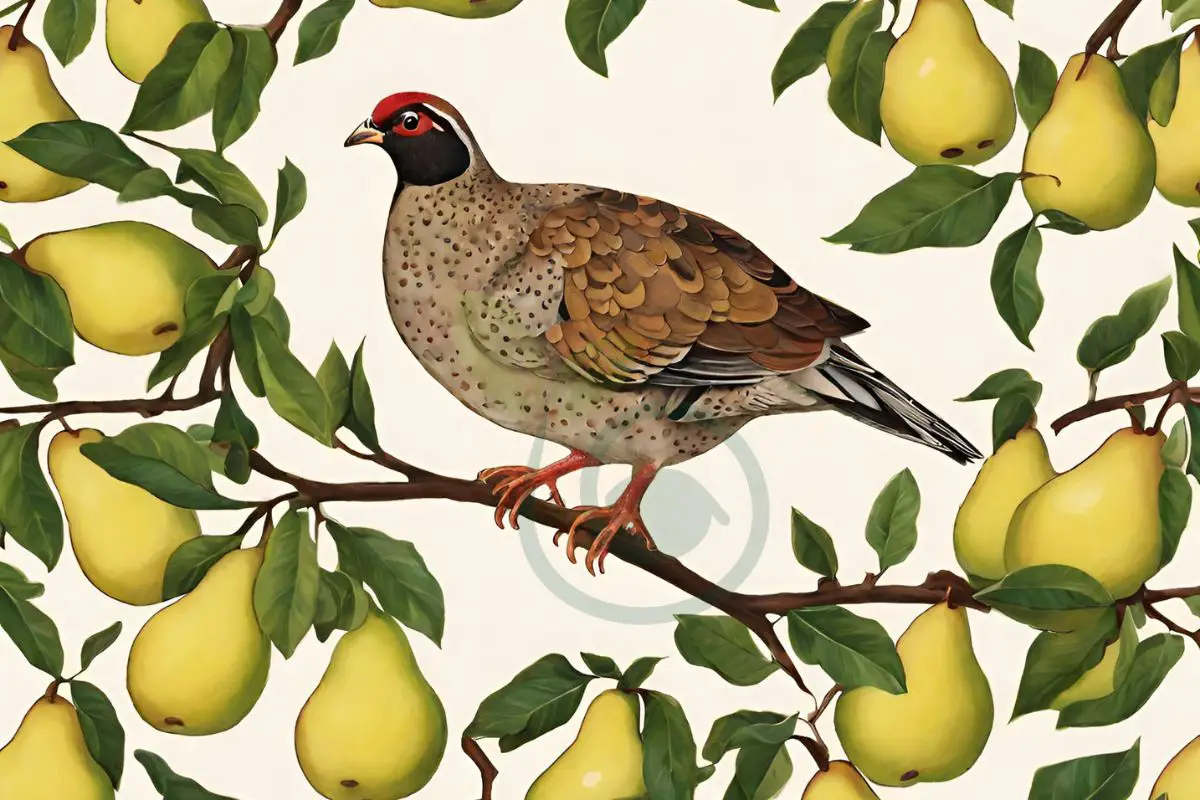Ever wondered about the mysterious partridge in a pear tree from the classic holiday song? Let's delve into what this iconic image actually looks like. Dating back to the 18th century, this symbolizes a lavish gift with historical significance. The partridge represents Christ, while the pear tree symbolizes His cross or salvation. This visual metaphor conveys religious themes and has become synonymous with festive cheer during Christmas celebrations.
Key Takeaways
- Understanding the appearance and behavior of a partridge in a pear tree can enhance your appreciation of nature.
- Observing pear tree characteristics can help identify habitats where partridges may thrive.
- Exploring the significance of partridges in pear trees across cultures reveals their symbolic importance.
- Distinguishing between real and mythical aspects of partridges in pear trees adds depth to folklore and storytelling traditions.
- Supporting conservation efforts for partridges and their habitats contributes to preserving biodiversity.
- Seeking viewing opportunities in natural settings allows for firsthand encounters with these fascinating birds.
Partridge Overview
Species Types
Partridges, members of the Phasianidae family, encompass various species globally. Among them are the gray partridge and the chukar partridge. These birds have distinct characteristics based on their species and geographic location. For example, while some prefer grasslands, others thrive in woodlands.
The diversity within the partridge family extends beyond just these common species. From Europe to Asia and Africa, different types of partridges can be found across continents. Each type, including quail, adapts to its environment uniquely, showcasing a range of behaviors and physical traits that set them apart from one another.
Physical Appearance
Partridges are known for their compact bodies equipped with short wings and tails that aid in swift movements through various terrains. Their plumage is often brown or gray with intricate patterns that provide camouflage amidst natural surroundings like grasslands or woodlands.
These birds possess short and sturdy beaks designed for efficient feeding on seeds and insects—a crucial adaptation for survival in their preferred habitats where food sources may vary seasonally.
Habitat Preferences
Inhabiting diverse environments such as grasslands, woodlands, farmlands, partridges seek out locations offering both cover for protection against predators and open spaces for easy access to food sources like seeds or insects. This adaptability allows them to thrive across different ecosystems based on availability of resources.
For instance, some species might migrate between habitats depending on factors like climate changes or human interference affecting their traditional living areas.
Pear Tree Characteristics
Tree Description
Pear trees, belonging to the Rosaceae family, are deciduous trees recognized for their unique appearance. With a broad crown and delicate branches, they stand out in orchards and gardens. These trees bear fruit known as pears that are widely used in various culinary dishes. The fruits come in different shapes, sizes, and colors depending on the variety of pear tree.
Pear trees thrive best in well-drained soil under full sun exposure to support their growth. During winter, these trees enter a dormant phase before bursting into vibrant blossoms during springtime. These blossoms eventually transform into young pears that mature throughout the warm summer months until they are ready for harvest.
Partridges in Pear Trees

Chukar and Gray
Chukar partridges, originally from Eurasia, have spread to various parts of the world. On the other hand, gray partridges are commonly found in Europe, Asia, and some regions of North America. While these species look alike physically, they thrive in different natural habitats. For instance, chukar partridges adapt well to diverse environments worldwide.
Gray partridges prefer specific regions like Europe and Asia due to their distinct environmental requirements. Despite their physical similarities with chukars, gray partridges exhibit unique behaviors based on their habitat preferences. These birds showcase how partridges can adjust to varying conditions while maintaining similar appearances globally.
- Chukar and gray partridges share physical resemblances.
- They differ in natural habitats despite looking alike.
Snow and Madagascar
Snow partridges reside in high-altitude areas across Central Asia where snowy mountainous terrains prevail. In contrast, Madagascar partridges are exclusive to the island of Madagascar near Africa's eastern coast. These two types of birds have evolved differently due to the distinct environments they inhabit.
Adapted for snowy landscapes, snow partridges demonstrate resilience in harsh weather conditions typical of high altitudes. Meanwhile, Madagascar partridges have thrived uniquely on an isolated island environment over time.
- Snow and Madagascar partridge species adapted uniquely.
- They excel in specific environments tailored to their needs.
Ruffed Grouse and Quail
Ruffed grouse originate from North America known for elaborate courtship rituals distinguishing them within the bird family. Comparatively small ground-dwelling creatures like quails populate various global regions outside North America but share some habitat preferences with ruffed grouse despite not being true partridge species.
Ruffed grouse stand out with distinctive courtship displays that differentiate them from other avian species native to North America such as quails that also exhibit ground-dwelling habits akin to certain partridge breeds around the world.
Observations in Nature
Birdwatchers often spot partridges in various regions worldwide, such as grasslands, agricultural fields, or near shrubby areas. These birds can be quite elusive depending on their species and may require specific locations or seasons for sightings. For example, the Grey Partridge is commonly found in farmlands across Europe and Asia.

Different species of partridges have distinct habitats they prefer; for instance, the Chukar Partridge thrives in rocky terrains from southern Europe to the Middle East. These observations showcase the adaptability of partridges to diverse environments. Bird enthusiasts might need keen observation skills to catch a glimpse of these birds due to their camouflage abilities.
Significance in Culture
Historical Context
Partridges, often depicted in art and literature, hold cultural importance across civilizations. Exploring their historical context unveils the symbolism linked to these birds. For instance, ancient Greek mythology portrays partridges as symbols of protection and motherly care.
In Chinese culture, partridges symbolize prosperity and family unity. Their presence in folklore reflects themes of loyalty and devotion. Understanding these historical representations provides a glimpse into the values esteemed by different societies throughout history.
Modern Symbolism
Partridges continue to carry symbolic meanings today, embodying concepts like fertility, abundance, and good luck in various cultures worldwide. The association with the holiday season stems from the popular Christmas carol featuring a "partridge in a pear tree." This link has solidified partridges as emblematic figures during festive celebrations.
In contemporary contexts, partridges represent harmony and togetherness. They serve as reminders of the importance of unity amidst diversity—a reflection on how different elements can come together to create something beautiful.
Real vs. Mythical
Actual Occurrences
Partridges perched on pear trees are rare in nature, leading to the phrase "partridge in a pear tree" being more of a metaphor. Occasionally, partridges do rest or feed on trees or shrubs.
In real life, spotting a partridge nestled among the branches of a pear tree is uncommon. The phrase is often used figuratively rather than describing an actual event. For instance, if someone were to say they received "a partridge in a pear tree" as a gift for Christmas, it's likely symbolic rather than literal.
Mythical Representations
Myths and legends across various cultures depict partridges as symbols of different virtues like protection, wisdom, and transformation. These mythical representations add depth to the cultural significance associated with these birds.
Across myths from diverse backgrounds, partridges frequently symbolize concepts such as true love and loyalty. In ancient folklore tales, these birds play essential roles embodying qualities that resonate deeply within human experiences and emotions.
Conservation Efforts
Grey Partridges
Grey partridges, often found in various agricultural landscapes, are known for their adaptability. They have a diet primarily consisting of seeds, grains, and insects commonly found in farmlands. To ensure the survival of gray partridge populations, conservation efforts are crucial.
Conservation strategies focus on maintaining suitable habitats for gray partridges to thrive. By preserving these environments rich in food sources and shelter, populations can flourish. For instance, farmers may implement practices that provide both food and cover for these birds.
Habitat Restoration
Habitat restoration initiatives play a vital role in creating or improving environments suitable for partridges. This involves planting native vegetation to enhance biodiversity while managing land use practices to support the needs of these birds. Moreover, reducing habitat fragmentation is key to ensuring the continuity of their habitats.
Restoration efforts contribute significantly to the conservation of not only grey partridge populations but also the ecosystems they inhabit. By restoring degraded areas back to their natural state through targeted actions like reforestation or wetland restoration projects, the overall health of these ecosystems improves.
Viewing Opportunities
Best Locations
Partridges can be found in various habitats depending on the species and region. Grasslands, agricultural fields, and nature reserves are ideal spots for spotting them. Local birdwatching guides or experts can offer valuable insights into prime locations where partridges are commonly sighted.
Understanding the seasonal timing is crucial. The timing of sightings varies based on species and local climate conditions. Breeding seasons, migration patterns, and food availability all play a role in influencing when and where partridges can be observed.

Seasonal Timing
By knowing the breeding seasons and migratory habits of different partridge species, you can plan your birdwatching excursions more effectively. For instance, during breeding season, male partridges may engage in elaborate courtship displays to attract mates. This behavior makes them more visible in their natural habitat.
Birdwatchers keen on observing specific behaviors like courtship displays should time their visits accordingly to increase their chances of witnessing these captivating moments in nature.
Engaging with Nature
Photography Tips
To capture the beauty of a partridge in a pear tree, consider using camouflage or hideouts to approach them discreetly. This method allows you to photograph intricate plumage patterns and unique behaviors like courtship displays without causing disturbance. Telephoto lenses can help you take stunning shots from a distance while respecting their natural behavior.
When taking pictures of these birds, it's essential to prioritize their welfare by minimizing any potential disruptions. Avoid getting too close or causing unnecessary stress that could impact the partridges negatively. By following ethical guidelines for birdwatching and showing respect for their natural behaviors and habitats, you can enjoy capturing these moments responsibly.
Ethical Watching
While observing partridges in a pear tree, remember that they are living creatures deserving of our care and respect. By maintaining a safe distance and refraining from disturbing them unnecessarily, we show our appreciation for these beautiful birds' existence. Respecting their space ensures that they can go about their daily activities undisturbed.
If you love nature photography and want to document the charm of a partridge perched on a pear tree branch, make sure your actions align with ethical standards for wildlife observation. Prioritizing the well-being of these birds not only benefits them but also allows us to witness their grace without intruding on their world.
You've delved into the world of partridges in pear trees, uncovering their significance in both nature and culture. From their unique characteristics to conservation efforts, you've gained a deeper appreciation for these birds and their habitat. Remember, every action counts.
Take the time to observe nature around you, whether it's a simple walk in the park or a bird-watching adventure. Your engagement with the natural world not only enriches your life but also plays a vital role in preserving biodiversity. So, go out there, explore, and make a difference in your own way!
Frequently Asked Questions
What is the significance of a partridge in a pear tree?
The partridge in a pear tree symbolizes abundance and generosity, often associated with the holiday season. It represents giving and gratitude, reflecting nature's beauty and harmony.
How can I identify a partridge in a pear tree?
A partridge is known for its distinctive markings like mottled brown feathers and red legs. When perched on a pear tree, it may blend with the leaves but watch for its small size and unique coloring.
Are there real-life observations of partridges in pear trees?
Yes, sightings of partridges resting or feeding on fruit trees like pears are common. These birds seek shelter and food among orchards, showcasing their natural behavior up close.
What efforts are being made to conserve partridges in their habitat?
Conservationists focus on preserving both woodland habitats for nesting and farmlands for feeding grounds. By promoting sustainable farming practices and protecting forests, they aim to safeguard these birds' populations.
Where can I find opportunities to view partridges in their natural habitat?
Nature reserves, bird sanctuaries, or rural areas with fruit-bearing trees offer ideal locations to spot partridges. Joining guided birdwatching tours or exploring countryside trails increases your chances of encountering these fascinating creatures.
Image Source: Paid image from CANVA


